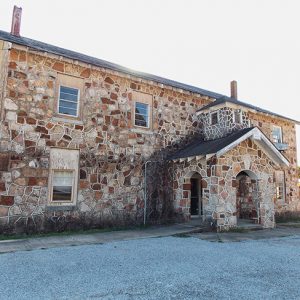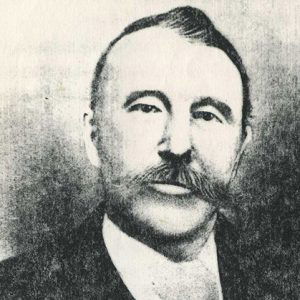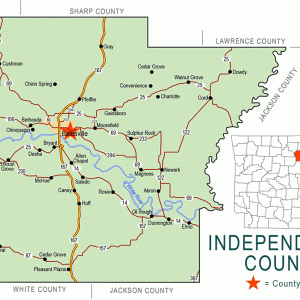calsfoundation@cals.org
Charlotte (Independence County)
Charlotte is located just off Highway 25 (a.k.a. White Drive) on Old School Road near the banks of Dota Creek, twelve miles east-northeast of the county seat of Batesville (Independence County) and about five miles west of Cord (Independence County). Rich farmland lies to the south of Charlotte in the Big Bottom alluvial lands along the Black and White rivers. There is also high-quality grazing land for cattle in the Charlotte region. Charlotte is in the township of Dota, which includes three churches—Cedar Grove Church, Center Grove Church, and Pleasant Hill Church.
In 1852, seventeen-year-old James Northcroft Churchill crossed the Mississippi River from Tennessee with his family, which settled in Walnut Grove (Independence County). A few years later, he opened a store and married Charlotte Hogan, whose grandfather David Hogan had founded Walnut Grove in 1830.
With business prospering and the community growing, Churchill added a post office to his store and was appointed the first postmaster in December 1883. The U.S. Postal Service accepted his request that the new post office be called Charlotte, for his wife. Charlotte Churchill is buried in the Walnut Grove Cemetery, and her husband is buried in the Charlotte Cemetery next to his second wife, a widow he married following Charlotte’s death.
One of the first settlers of Charlotte was Richard David Fallis of Kentucky, who, shortly after the Civil War, moved to Gainsboro (Independence County), about five and a half miles west-northwest of what would become Charlotte. He bought several acres of farmland along Dota Creek and added to his holdings by marrying Sarah Moody, a granddaughter of Thomas Todd Tunstall, who was a riverboat captain, businessman, and one of the most prominent landowners in Big Bottom. One of their sons, Archie Edward Fallis, became a leading citizen of Charlotte and is buried in Charlotte Cemetery.
In 1920, Will Duvall organized a stock company and began operating a general store in Charlotte, adding to his other stores in other parts of the region, including Sharp and Van Buren counties, as well as Independence County; his first store opened at nearby Sulphur Rock (Independence County) in 1913. Duvall was a significant dealer in goods, buying and selling livestock, cotton, produce, and just about any legal commodity of value. He had his own cotton gin and operated a bank in the 1920s and 1930s.
The prominent country physician Dr. James Peter (Jim) Dorr, a frontier doctor who traveled from community to community and often bartered for his fees, practiced medicine on Dota Creek and the surrounding communities, including Charlotte, from the 1880s until his death in 1930. Dorr opened a general store along Dota Creek near Charlotte that sold caskets in the back room. His brother, Dr. Robinson C. (R. C. or Rob) Dorr, who first practiced with his brother in the Charlotte area, moved to Batesville in 1897. The two brothers studied medicine under their father (who had bought land between the Black River and Sulphur Rock along Dota Creek just after the Civil War) and graduated from what is today Washington University in St. Louis, Missouri.
The Bayou Dota Academy was established in 1858. During the Great Depression, the old wooden building used by the academy was replaced in 1936 with one made of sandstone built by the Works Progress Administration (WPA). While this school was being constructed, school was held in the Methodist church building behind what was then Weaver’s Store. The WPA building is in use today by the school district, with the Bayou Dota Masonic Lodge No. 126 holding its meetings upstairs. In 1952, the Charlotte and Cord schools merged to form the Cord-Charlotte School District. In 2004, Cord-Charlotte consolidated with the Newark (Independence County) school district to create the Cedar Ridge School District. Cord-Charlotte still has an elementary campus for grades K–6.
Charlotte and the older nearby community of Cord have always had close ties. Many from other parts of the county use the term Cord-Charlotte to mean the same town—with the confusion deepening when the Cord-Charlotte School District was created in 1952—but each town has its own unique identity and history.
For additional information:
Arms, Orville. “A Brief History of the Cord-Charlotte School District.” Unpublished essay, 1998. On file at the Butler Center for Arkansas Studies. Central Arkansas Library System, Little Rock, Arkansas.
Elms, Mrs. V. C. “Medical Practitioners of Independence, Sharp, and Izard Counties in 1909.” Independence County Chronicle 10 (July 1969): 22–27.
Lucas, Perry E. “Service on the Charlotte Line.” Independence County Chronicle 4 (July 1963): 17–18.
McGinnis, A. C. “A History of Independence County, Ark.” Special issue. Independence County Chronicle 17 (April 1976).
Kenneth Rorie
Van Buren, Arkansas
 Charlotte School
Charlotte School  James Churchill
James Churchill  Independence County Map
Independence County Map  Oak Bluff School
Oak Bluff School 



Comments
No comments on this entry yet.